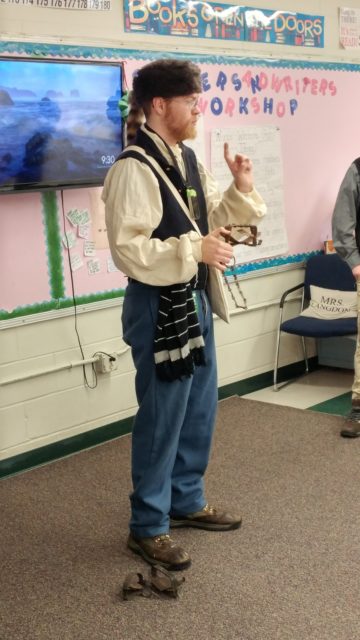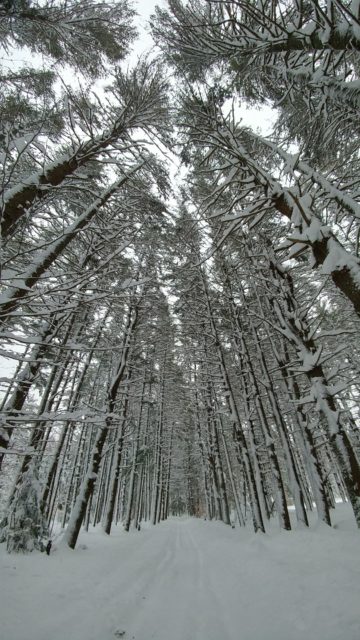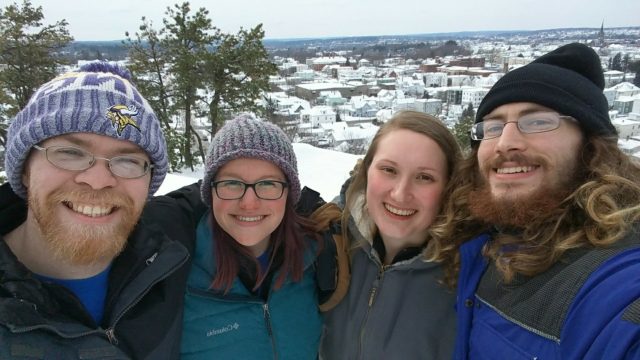By: Rachel Shoemaker 2018 SCA NH AmeriCorps Member
Furbearing mammals like the gray fox and short-tailed weasel (ermine) are fascinated by the Subnivean zone and so is this born-and-raised North Carolinian. After taking a road trip with my family this past summer and seeing the beautiful state of New Hampshire in all its glory, I was absolutely delighted to find out I’d be working and living at Bear Brook State Park starting in January. January 9th, to be exact… Myself and nearly 30 other newly inducted Bear Brookers arrived just after a brutal winter storm that had dumped 13 inches of snow and had frozen the pipes. It was a beautiful and sobering welcome to my first New England winter.
During our training to become newly fledged environmental educators for Education Season, a Fish and Wildlife employee came to speak about furbearing mammals that overwinter in NH. As I was listening to the lecture, the words “ermine” and “Subnivean zone” piqued my interest. I had never heard those words before! As the presentation went on, I took as many notes as possible and knew right away that I wanted all the third and fourth graders in my classes to learn about these things. A couple of weeks later, my teaching team successfully made this happen.
Our lesson started off with a trip back in time featuring “Nick the Fur Trapper.” One individual from my teaching team dressed in a traditional fur hunter uniform from the 18th Century – even a coonskin hat – and discussed the traps that were used.

After also discussing modern, more humane hunting methods and ethics, we introduced types of winter survival techniques, most specifically insulation. Various mammals that live in NH grow thicker fur, consisting of long, stiff guard hairs and insulating under fur. Some examples are the American beaver, striped skunk, gray fox, and ermine. However, this still doesn’t explain how they survive through the winter with enough food to eat. This brings me to the Subnivean zone.
Oh, the wonders of the Subnivean zone! This consists of series of tunnels between the snowpack and ground that small mammals like mice, voles, and shrews utilize to stay warm, eat, and evade predators. Thanks to the insulation that the snowpack provides, it never freezes, and interestingly, it can even contain homey features like a breakfast nook, bedroom, and toilet. Ideal, but not perfect. Ermines only weigh 2-7 ounces and have a long, slender body that enables them to squeeze through the labyrinth and stealthily hunt their prey. Foxes are also quite adept at using their keen sense of hearing to pinpoint the location of the small, scurrying creatures and BAM! jumping headfirst and crashing through the snowpack into the tunnel. Not only does this mean an abrupt end for an unlucky mouse, but also a collapsed, unusable section of the tunnel for the other residents.
Humans are capable of collapsing these tunnels as well. My teaching team had the opportunity to illustrate this idea with a parachute game.

Three students were designated as mice and one as a fox. The mice crawled underneath the parachute and while the rest of the class wildly flapped the edges of the parachute around, the fox tried to hunt the mice. It was difficult, as the fox couldn’t see their prey (only hear the occasional excited giggle). However, once a wooden plank was placed in the middle of the parachute, the predator was much more efficient at locating their prey. This plank, resembling human infrastructure (road, trail, bridge, etc.), essentially cut off the tunnels from one another. No longer could the mice pass through – they would have to go back the way they came, exit, run out in the open in hopes that a predator didn’t see them, and reenter the zone from the other side. Not great odds of survival.
The other week after our third nor’easter in under two weeks (much to the astonishment of this North Carolinian), I had a eureka moment about the Subnivean zone. After discovering that my classes were cancelled, I went on a walk and delightfully trudged through two feet of snow to admire the winter wonderland.

My first thoughts were to run around like a crazy person and snap as many pictures of different things as possible, but after stepping off the snowmobile trail a few feet, I froze. It’s freaking cold, I thought, I bet with all this fresh snow, I’m not the only one trying to stay warm…oh no, the Subnivean zone! I returned to the trail and kept on, pleased to have solidified a connection between my learning and a practical, real-life scenario.
What we always try and teach our students is that nature is awesome!

There is always something new to learn and all of it is relatable to us in some way. Every day we have the choice to make a positive impact on the natural world and even if it seems like something small, it matters. Not everyone may be as obsessed with the Subnivean zone as I am, but luckily, there is an entire world to explore in all its wondrous glory.

